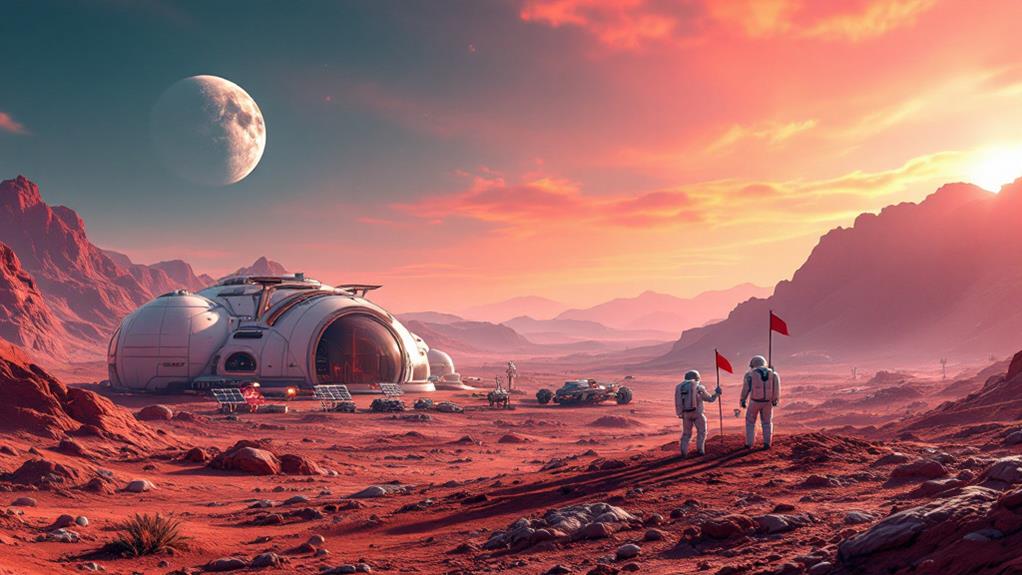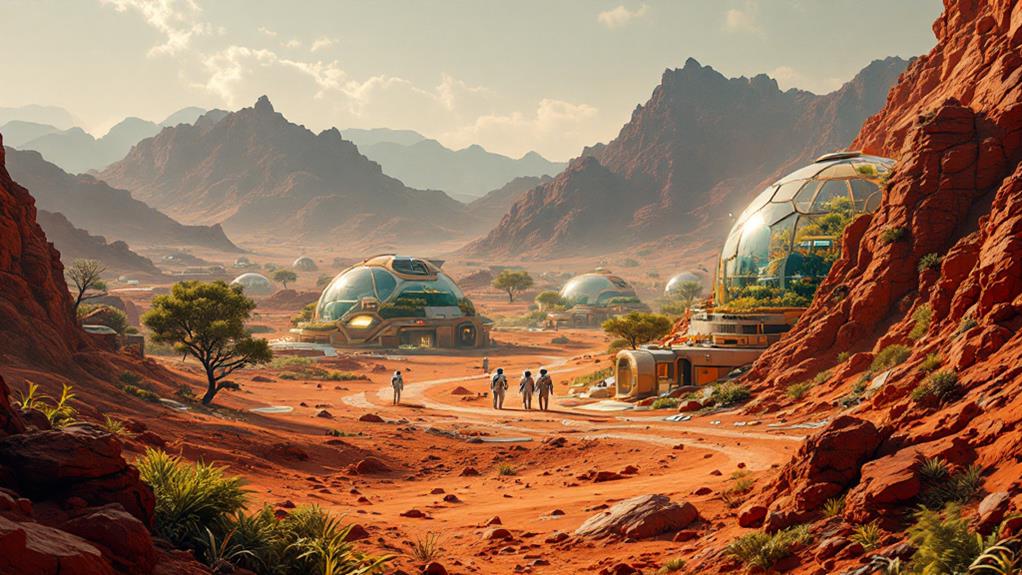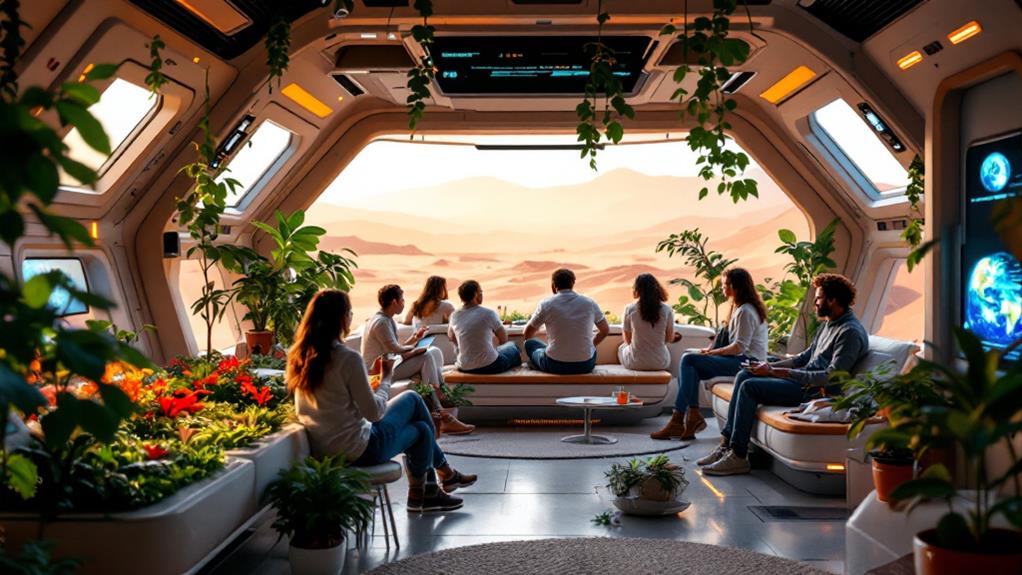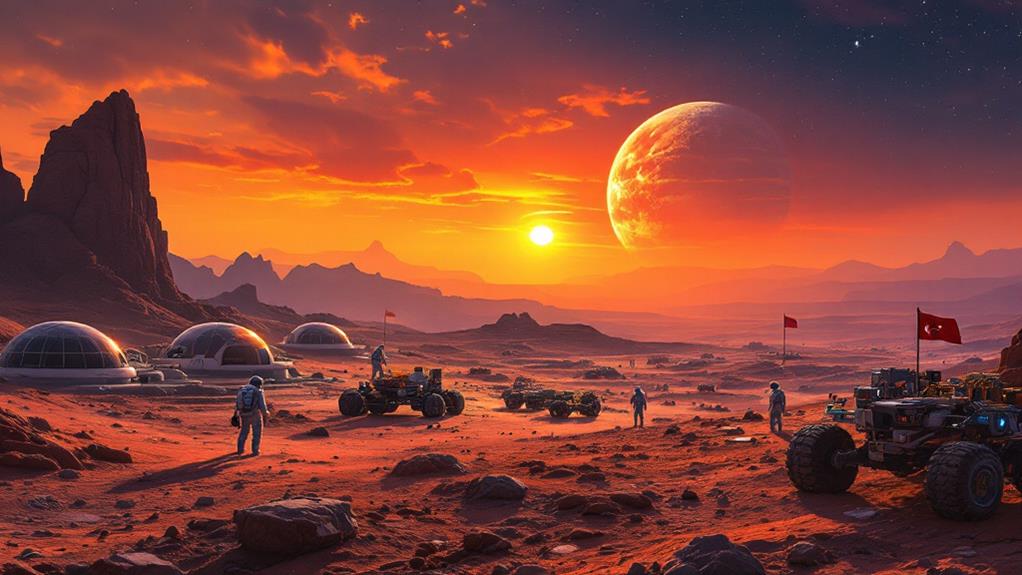Colonizing Mars: Can This Dream Become a Reality?

You're on the brink of witnessing humanity's dream of colonizing Mars become a reality. Current Mars rovers like Perseverance are essential, advancing your understanding of Martian geology. Progress hinges on breakthroughs in sustainable energy and robotic autonomy for constructing habitats. Tackling harsh radiation, technology for in-situ resource utilization, and food production systems will be vital. Psychological resilience and collaboration guarantee a thriving Martian community. Manned missions are planned for the 2030s, aiming for sustainable habitats by 2040. As international cooperation shapes these endeavors, you'll uncover how these plans unfold into a new age of interplanetary living.
Current Mars Exploration Efforts
The expedition to Mars has captured the imagination of scientists and enthusiasts alike, sparking a series of ambitious exploration efforts. You've likely noticed how Mars rover advancements have played a vital role in these missions. With each new rover, we've seen leaps in technology that allow for more detailed exploration of the Martian surface. Rovers like Perseverance and its predecessors have paved the way for understanding Mars' geology and searching for signs of past life.
International collaboration has become a key component in current Mars exploration efforts. Countries around the world are pooling resources and expertise to overcome the challenges of space exploration. This cooperation not only improves our understanding of Mars but also fosters peaceful relations on Earth. Agencies like NASA, ESA, and their global partners are working together to share data and develop strategies for future manned missions.
Technological Breakthroughs Needed
Many technological breakthroughs are vital for turning the dream of colonizing Mars into a reality. You need to focus on robotic autonomy and sustainable energy to lay the groundwork for a successful Martian settlement. Robotically autonomous systems will play an important role in the initial stages of colonization. These machines can perform tasks like building habitats, conducting scientific research, and even mining resources without direct human intervention. By developing autonomous robots, you guarantee a safer and more efficient operation, reducing the risks associated with human involvement in a harsh Martian environment.
Sustainable energy is another cornerstone for Mars colonization. You can't rely on traditional power sources that are commonplace on Earth. Instead, you'll need to harness renewable energy like solar and nuclear power to sustain life on the Red Planet. Solar panels can provide clean energy, but you'll need to address the challenge of reduced sunlight during Martian dust storms. Nuclear energy offers a reliable alternative, assuring that your colonists have a constant power supply. By mastering these technological advancements, you take significant steps toward transforming the dream of a Martian colony into a tangible, sustainable reality.
Overcoming Environmental Challenges

Despite the allure of Martian colonization, you're faced with formidable environmental challenges that demand creative solutions. Mars's harsh conditions require inventive radiation protection to shield settlers from harmful cosmic rays. Without Earth's magnetic field, devising robust shielding is fundamental. Habitat design becomes significant in providing safe and livable spaces. Consider creating structures that adapt to Martian conditions, enhancing insulation and pressure control while ensuring they remain light and transportable from Earth.
Resource utilization is another pivotal factor. You're looking at the potential of in-situ resource utilization (ISRU) to extract water, oxygen, and other necessities from Martian soil and atmosphere. This reduces dependency on Earth-based supplies and fosters self-sufficiency.
Terraforming methods offer long-term solutions but raise environmental ethics questions. Altering Mars's environment could have unintended consequences, so you're tasked with balancing progress and preservation of its natural state. In the meantime, sustainable agriculture is necessary for producing food. You'll experiment with growing crops in Martian soil, perhaps using hydroponics or aeroponics to enhance efficiency.
Addressing these challenges requires a delicate blend of technology and ethics, ensuring that Mars colonization is both feasible and responsible.
Life-Support Systems on Mars
As you tackle the environmental challenges of Mars, you'll find that life-support systems form the backbone of a sustainable colony. Ensuring survival on the Red Planet requires inventive habitat design that incorporates robust radiation protection. You'll need structures that shield you from cosmic rays and extreme temperatures while creating a comfortable living space.
Resource utilization is key to reducing dependency on Earth. By harnessing Mars' natural resources, you can facilitate atmospheric processing, converting carbon dioxide into breathable oxygen. Water extraction from subsurface ice deposits becomes essential, providing water for both consumption and sustainable agriculture. Growing food on Mars demands carefully managed agricultural systems that recycle nutrients and enhance crop yields.
Energy generation is another significant element. Solar panels or small nuclear reactors can offer reliable power sources, supporting everything from habitat climate control to scientific equipment. Effective waste management is imperative to maintaining a clean and organized environment. Implementing systems that recycle waste into usable resources will support ongoing colony operations.
Psychological and Social Considerations

Establishing a colony on Mars isn't just about technology and resources; it's also about nurturing the psychological and social well-being of its inhabitants. As you prepare for life on the Red Planet, mental health becomes a top priority. You're venturing into an environment that can be isolating and stressful, so understanding community dynamics is essential. Maintaining a positive atmosphere and strong group cohesion will help settlers adapt more easily to their new home.
Cultural adaptation is another significant factor. You'll encounter people from diverse backgrounds, each bringing unique perspectives and traditions. Embracing this diversity can improve identity formation and create a rich, lively community. It's necessary to foster an environment where everyone feels valued and included, helping to build a shared identity that transcends Earthly origins.
Social support systems play a crucial role in your well-being. Establishing networks where settlers can share experiences, challenges, and solutions is indispensable. These connections provide the emotional and psychological support needed to thrive in an alien world. By prioritizing these aspects, you can guarantee that the community not only survives but flourishes, making the dream of colonizing Mars a sustainable reality.
Economic and Political Factors
While psychological and social well-being are fundamental for a thriving Mars colony, economic and political factors are just as significant. Establishing a colony on Mars requires massive investment and careful resource allocation. You need to evaluate the costs of transporting materials, building habitats, and supporting life in an unforgiving environment. These costs aren't just financial; they're also about efficiently using limited resources to guarantee the survival and growth of the colony.
International cooperation is imperative in this endeavor. No single nation can shoulder the burden of Mars colonization alone. By working together, countries can share the financial, technological, and intellectual resources needed for such a monumental task. This cooperation can help distribute costs and risks, making Mars colonization more feasible.
Moreover, political factors play a key role in shaping the future of Mars colonization. Establishing who governs a Mars colony and how laws are created and enforced will require international dialogue and agreements. You must navigate complex geopolitical landscapes to guarantee that Mars remains a place of collaboration rather than conflict. A successful Mars colony hinges on the ability to balance these economic and political factors, paving the way for humanity's next giant leap.
Timeline for Mars Colonization

Mapping out a timeline for Mars colonization involves careful consideration of technological advancements and logistical planning. You'll need to start by projecting the development and implementation of key technologies, including efficient spacecraft and sustainable life-support systems. In the next decade, focus on sending robotic missions to test terraforming methods and gather data on Martian resources. These missions will help refine strategies to utilize local materials, such as regolith, for construction and oxygen production.
By the 2030s, aim to establish a permanent human presence with the construction of initial habitat designs. These habitats should offer protection from radiation and harsh environmental conditions, using inflatable modules or underground structures. You'll want to guarantee these habitats support life for extended periods, with systems for water recycling and food production.
In the 2040s, focus on expanding the colony and improving infrastructure. Implement advanced terraforming methods to gradually modify the Martian atmosphere, making it more Earth-like. This might involve releasing greenhouse gases to warm the surface, although this process will take centuries. Throughout each phase, rigorous testing and international collaboration are vital for success. With careful planning, colonizing Mars can shift from dream to reality within a few decades.



